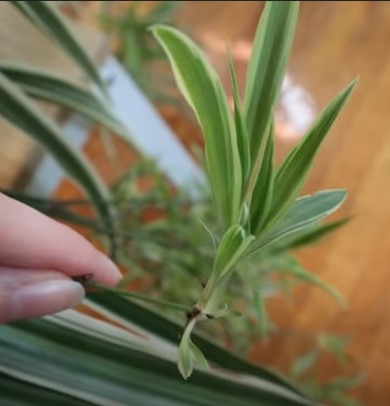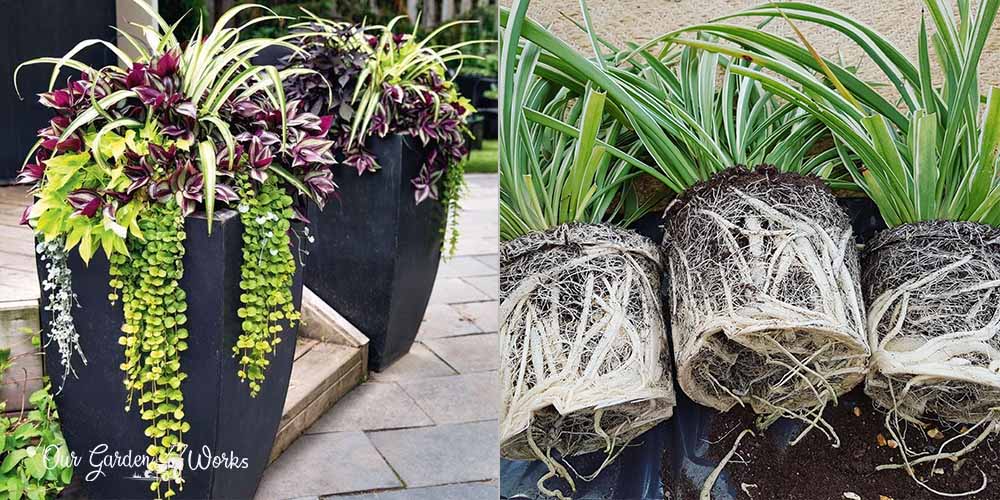The fast-growing spider plants are the best starter plant for beginners. They are very resilient, not picky, and neglect-safe. Due to their fast-growing habit, they can easily be pot-bound or rootbound. So most people ask, do spider plants like to be root bound or will they choke like other houseplants?
In this post, learn more about the quirks of spider plants, how to handle their self-propagation process, and the most creative ways to add them to your home interior design.
We will also discuss how to deal with rootbound spider plants and the warning signs you need to check if it’s time to re-pot them.
Q: Do Spider Plants Like To Be Root Bound?
A: Yes, spider plants like to be root bound but at a moderate level. Usually, houseplants get sick or die when they’re pot-bound.
There are too many roots that fail to absorb oxygen and retain too much water causing the plant to rot. Spider plants are especially unique in this forte. Being slightly root-bound allows spider plants to:
- Produce a lot of pups.
- Encourage bloom growth.
- Grow new spider plants within the same pot.
- Increased tolerance for neglect.
Spider plants are the kind of houseplants that can propagate with little to no care at all.
Due to their self-propagating nature and easy growing habit, they are a perfect plant for beginners, black thumbs who try their luck in growing a plant, and busy individuals like students and the working group.
It takes around 6 months to a year for a spider plant to become root bound. Some spider plants may not show any signs on the surface that they’re already growing and have long chunky roots. However, they will give you subtle hints that they are already having some root party in the pot, such as:
- Roots peek at the topsoil and pot edges and even elevate the whole plant from the soil.
- The plants started to grow stolons with tons of pups or spiderettes.
- The water gets absorbed faster than usual.
The best way to know that your spider plant is already pot-bound is to pull them out.
These chunks of roots will usually adapt to the size of the pot and grow around it. As long as there are no visible signs of plant health decline, you can leave your root-bound spider plants alone.

When should you re-pot a spider plant?
A spider plant can tolerate neglect but not when it’s severely root bound. The problem usually arises when the plant has developed so many roots that it becomes waterlogged and nutrient deficient.
Spider plants can also be a great headache when they start to grow roots around the nursery pot.
A single spider plant can develop several new growths within the same pot which competes with water and nutrients in the soil.
In other cases, the roots will grow around the drainage hole of the pot and cause water retention leading to root rot.
Signs that your root-bound spider plant needs repotting
- Roots peeking around the drainage holes.
- Yellowing leaves.
- Rapid water absorption.
- Droopy and sick-looking leaves
- Stunted growth.
- Bad smell on the pot.
One of the unique qualities of spider plants is developing several pups through its stolons. The stolons are long-growing rhizome-like stems that usually extend out of the pot. Both stolons and roots of spider plants can get crowded pretty fast which requires frequent repotting.
Repotting spider plants involves pruning its new pups and trimming the new growth from the mother plant.
The root-bound plants may still thrive in a bigger pot without pruning. However, cutting off excess roots and new growth will help them absorb oxygen, nutrients, and water better.
Pruning is crucial if there is already an onset of root rot in the root-bound spider plant. You need to cut all of the rotten roots before repotting them.
Stressed spider plants are very vulnerable to pest infestations and fungal diseases. So, you should also spray the plant with a fungicide as a preventive measure.
Propagation Technique I: How To Split a Root-bound Spider Plant
As soon as you pull up a root-bound spider plant, you’ll surely be shocked by the complexity of its root system. It will look impossible to split the spider plants because the roots are closely intertwined with each other.
Many people assume that splitting the root-bound spider plant will do more harm than good because it’s almost impossible not to wound the roots, especially when they are all tangled. It may look impossible but it’s doable as long as you divide the roots gently and with care.
Here’s how:
(1) Remove the plant from the pot and gently shake off the potting soil. Loosen the tangled roots by wiggling the plant.
(2) Inspect how many crowns you can separate from the mother plant. Check the image below to guide you on what a crown looks like. The mother plant below has produced three new crowns.

(3) To split the crowns from the mother plant, you’ll need to pull them away gently. You may need to sever some roots but it’s okay. As long as you keep most roots intact, the plant will just be fine.
(4) You may prune the spider plant roots to make them look tidy and get rid of some dried and rotten ones. You can leave at least three to six inches of healthy roots.
If the spider plant has root rot, you will notice that the roots are mushy and the tubers or the chunky parts of the roots are translucent. You have to get rid of all the rotten roots before repotting the plant.
If the remaining roots are very wet, it’s best to let them air dry for one to two days before repotting.

(5) Now, the newly divided spider plants can be planted directly in other pots. In choosing a pot for spider plants, it’s best to choose a terracotta pot because they have a porous texture that helps with optimal airflow for the roots that prevents root rot.
(6) Water them lightly and place them in areas with indirect light.
Propagation Technique II: How To Cut and Re-pot The Pups
Spider plants are one of the best plants to have at home since you can propagate through new crowns, as mentioned above and the pups.
Now, here’s how you can separate the pups from the mother plant and allow them to root in water:
(1) Check out the stolons hanging around the spider plants. Find the pups at the end of the stolons that are big enough to support themselves apart from the mother plant. Avoid the pups that have very small leaves and underdeveloped roots.
These underdeveloped pups need more time to develop so they can survive as new plants.

(2) Cut a few inches of the stolon to separate the pup. Make sure to use sanitized scissors or pruning shears when cutting the plant.

Avoid pinching off the pups to avoid wounding the mother plant. Wounding the stolons can attract spores of fungal disease and affect the mother plant’s health.
(3) Get a small bottle or vase as a rooting pot for the pups. Add water to the vase wherein you can submerge the base of the pup to push it to grow new roots. The roots of spider plants can be sensitive to minerals in tap water and cause crispy or browning leaf tips.
Opt for distilled water to prevent leaf problems but it is optional since the pups can still survive in tap water.

(4) Change the water every week and let the pups root on their own. When they successfully grow enough roots, you can re-pot them using soil as a medium.
Creative Spider Plant Landscaping Ideas
In repotting spider plants, you’ll surely end up with tons of new babies to grow. Spider plants are just generous like that.
So, what to do with so many spider plants other than to use them to improve your landscape and interior, right?
Here are some landscape and interior design ideas using spider plants:
Spider plants in outdoor landscape pots

Spider plants blend well with other types of houseplants with shades of violet and light green.
They also complement hanging plants that drape over pots like Dischidia. Other plants that are best to grow with spider plants are Wandering jew and Calathea.
Spider plants as edging plants to garden paths

The resilience and easy-growing nature of spider plants make them an ideal edging plant to pathways. They give off a bright ray of colors compared to evergreens which can make your yard look brighter and more lively.
Spider plants as a specimen plant in a Greek-inspired pot

Spider plants can easily fill up a specimen pot in your garden with their lively-looking foliage and bright colors. The stolons will also eventually hang around the pot adding a more dramatic look to your Greek-inspired pots.
Spider plants as bathroom elements

Spider plants are among the best plants placed in very humid areas like the bathroom. They add life to your plain white walls and make the bathroom more relaxing, especially when you soak in the bathtub after a long day.
Spider plants looking like hair to head-like pots

Nothing is probably more creative than using the curly and bendy foliage features of spider plants and placing them in head-like pots. They’re simple but catchy.
Here are some of the best head-like plant pots that you can try to mimic this look:
- YIKUSH Plant Pots Head Planter Pots for Plants.
- AIMEBBY Face Flower Pot Head Planter.
- HUNTHAWK Face Planters Pots Unique Face Flower Pot.
Spider plants as thriving greens in compact urban spaces

Growing plants in compact spaces are challenging, especially with the limited space and the environment that plants need.
With the fast and easy-growing nature of spider plants, they can survive in cramped window sills and balconies.
Spider plants as hanging plants in sunrooms

Hanging spider plants in your brightly lit patio or sunroom will make you appreciate the beauty of their ability to grow stolons and multiple pups. They are very versatile making them suitable to place in any corner of the house.
Spider plants added to live walls

The white and light green foliage of spider plants makes them a good contrast to the deep green and emerald colors of evergreens on live walls. You can also purposely use them to create some images or letters on the live wall.
Final Thoughts
Spider plants are unique in a special way that makes more and more gardeners love to have them at home.
When someone asks you the question: do spider plants like to be root bound, you can answer a resounding yes! They’re easy to grow, generous in propagation, and can be placed in any corner of yards and homes.
How do you design your garden with spider plants? Let us know in the comments!
Also, please don’t forget to share this post with your friends and encourage them to start growing spider plants too.
